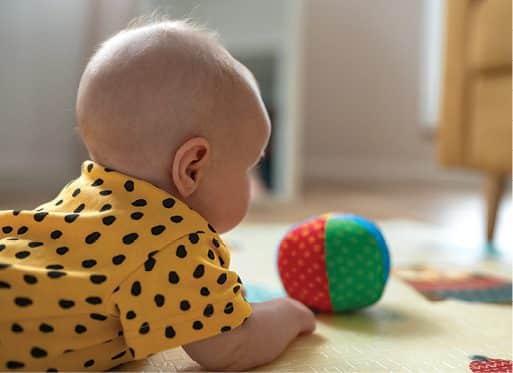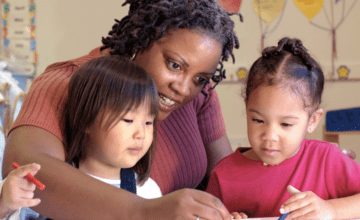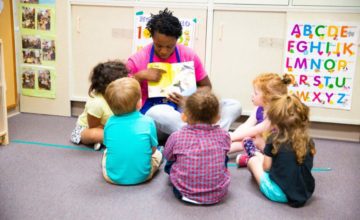Learn how to nurture your baby’s social emotional, intellectual, language, and motor development from 9 to 12 months. Explore more age ranges in our full Healthy Minds Series.
This handout is based on findings from a report From Neurons to Neighborhoods: The Science of Early Childhood Development* from the National Academy of Sciences that examined child and brain development in the early years. The information we offer is age-specific, summarizes key findings from the report, and suggests how you might be able to use these key findings to nurture your own child’s healthy development.
Key Findings
Findings from the From Neurons to Neighborhoods: The Science of Early Childhood Development include:
- Your relationship with your child is the foundation of his or her healthy development.
- Your child’s development depends on both the traits he or she was born with (nature), and what he or she experiences (nurture).
- All areas of development (social, emotional, intellectual, language and motor) are linked. Each depends on, and influences, the others.
- What children experience, including how their parents respond to them, shapes their development as they adapt to the world.
How Development Looks in Everyday Life
This example shows how all areas of Tyra’s development are linked and how her father’s response encourages her healthy development.
Eleven-month-old Tyra is with her dad, Kevin, at the park. Tyra is playing alone in the sandbox when a group of toddlers joins her. At first, Tyra smiles and eagerly watches their play. But as the toddlers become more active and noisy, Tyra’s smiles turn quickly to tears. She starts to crawl out of the sandbox and reaches for Kevin who picks her up and comforts her. But then Kevin goes a step further. After Tyra calms down, Kevin gently encourages her to play near them. He sits at her side, talking and playing with her. Soon Tyra is slowly creeping closer to the other children, curiously watching their moves.
Tyra’s looking to her dad for comfort shows that she has developed a close and trusting relationship with him. This is an important sign of her social and emotional development. She uses her intellectual skills to make a plan (“I want to be comforted by Dad, how do I do that?”), and her language (crying) and motor skills (crawling away, reaching up to Dad) to carry out the plan and successfully get the comfort she is seeking.
Relationships are the foundation of a child’s healthy development.
Kevin’s sensitive response has a powerful influence on what Tyra learns from this experience. He lets Tyra know that her needs and feelings are important. This will help Tyra develop future relationships based on love and trust. He is also letting her know that she is a good communicator, which will encourage Tyra to communicate more and more and help her develop good language and literacy skills. His response also makes Tyra a good problem-solver. She wanted comfort and she found a way to get it. By sitting with her near the other children, he lets Tyra know that she has the support she needs to successfully meet new challenges. This will help her feel confident to handle other challenges as she grows.
Charting Your Child’s Healthy Development
The following chart describes many of the things your baby is learning between 9 to 12 months and what you can do to support your child in all areas of her development. As you read, remember that children develop at their own pace and in their own way. Understanding who your child is, what her strengths are and where she needs more support, is essential for promoting her healthy development. If you have questions regarding your child’s development, ask your pediatrician.
| What’s going on: | What you can do: | Questions to ask yourself: |
|---|---|---|
| Babies this age are very good at expressing their feelings with their gestures, sounds and facial expressions. They can engage in “conversation,” for example, handing things back and forth to you, imitating each other’s sounds and actions. | Help your baby handle her feelings. Comfort her when she cries, acknowledge when she’s frustrated and help her calm down and try again. This helps your child manage her very strong feelings and develop self-control. | How would you describe your baby’s personality? In what ways are you and your baby alike and different? |
| They understand “cause and effect”– that they can make something happen: “If I cry, Mom will come.” | Engage in “circles” of communication with your baby. Keep it going as long as she’s engaged. If she reaches for a book, ask, “Do you want that book?” Wait until she responds, and then hand it to her. See what she does with it and join her without taking over. These “conversations” help boost her overall development—social, emotional, language, intellectual and even motor. | How does your baby let you know what she wants; what she’s thinking and feeling? |
| Thanks to their new memory skills, babies this age know that when you leave, you still exist. This is a very important skill, but also can lead to difficulty when leaving. This is why babies often protest at bedtime and cry out for you in the middle of the night. | Play hide-and-seek games like peek-a-boo. Disappearing and reappearing games like this help your baby learn to cope with separation and feel secure that you always come back. | How does your baby handle it when you leave? What helps make it easier? |
| Babies try to get you to come back by gesturing, crying and calling out. | Be positive when leaving her. Go to her at night to reassure her you are still there but don’t pick her up and rock her back to sleep. Falling asleep in your arms makes it more difficult for her to soothe herself back to sleep if she wakes up again at night. When saying “goodbye,” tell her you will miss her, but that you will return. Make sure she has something that gives her comfort, like her “blankie” or favorite stuffed toy. | What’s hardest for you about being away from your child? Being aware of your own feelings is very important. |
| Their ability to move in new ways (crawl, stand, even walk) makes it easier to explore and helps them make new discoveries, such as finding their favorite book under the chair. | Follow your child’s lead. The more she directs the play, the more invested she is and the more she will learn. | What does your baby do well? What does she find challenging? How can you be a partner in helping her face these challenges? |
*About “From Neurons to Neighborhoods”
The report From Neurons to Neighborhoods: The Science of Early Childhood Development was a 22-year effort by a group of 17 leading professionals with backgrounds in neuroscience, psychology, child development, economics, education, pediatrics, psychiatry and public policy. They reviewed what was known about the nature of early child development and the influence of early experiences on children’s health and well-being. The study was sponsored by a number of federal agencies and private foundations.
Download the PDF to view the original handout.



